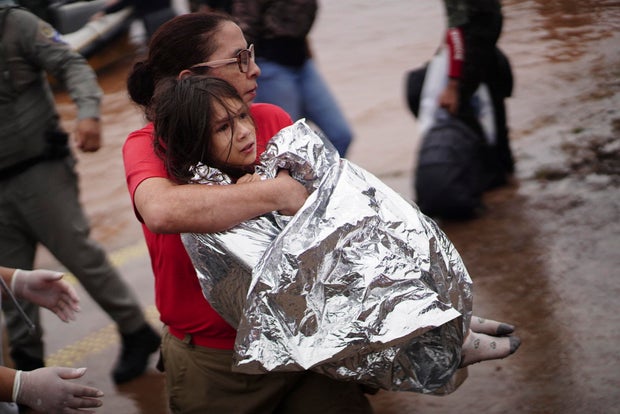Massive floods in the state of Rio Grande do Sul, in southern Brazil, killed at least 60 people and another 101 were reported missing, according to Sunday’s report from local authorities.
At least 155 people were injured, while rain damage forced more than 80,000 people to flee their homes. Approximately 15,000 took refuge in schools, gyms and other temporary shelters.
The floods left a trail of devastation, including landslides, destroyed roads and collapsed bridges across the state. Operators reported electricity and communications outages. More than 800,000 people are without water supply, according to the civil defense agency, which cited figures from water company Corsan.
Carlos Macedo/AP
On Saturday night, residents of the city of Canoas stood in muddy water and formed a human chain to pull boats carrying people to safety, according to video footage shared by local news network UOL.
The Guaíba River reached a record level of 5.33 meters (17.5 feet) on Sunday morning at 8am local time, surpassing levels seen during a historic 1941 flood when the river reached 4.76 meters.
“I repeat and insist: the devastation to which we are being subjected is unprecedented,” said the state governor, Eduardo Leite, on Sunday morning. He had already said that the state will need a “sort of ‘Marshall Plan’ to be rebuilt”.
Brazilian President, Luiz Inácio Lula da Silva, arrived in Rio Grande do Sul on Sunday, accompanied by the Minister of Defense, José Múcio, the Minister of Finance, Fernando Haddad, and the Minister of the Environment, Marina Silva, among others.
During Sunday Mass at the Vatican, Pope Francis said he was praying for the people of the state. “May the Lord welcome the dead and comfort their families and those who had to leave their homes,” he said.
Carlos Macedo/AP
The rain started on Monday and is expected to last until Sunday. In some areas, such as valleys, mountain slopes and cities, more than 300 millimeters (11.8 inches) of rain fell in less than a week, according to Brazil’s National Institute of Meteorology, known by its acronym INMET, on Thursday .
The heavy rains were the fourth environmental disaster of its kind in a year, following the floods of July, September and November 2023, which killed 75 people in total.
The climate in South America is affected by the El Niño climate phenomenon, a periodic and natural event that warms surface waters in the Equatorial Pacific region. In Brazil, El Niño has historically caused droughts in the north and intense rains in the south.
Carlos Macedo/AP
This year, the impacts of El Niño were particularly dramatic, with a historic drought in the Amazon. Scientists say extreme weather is happening more frequently due to human-caused climate change.

























